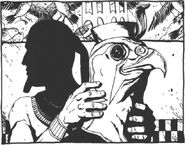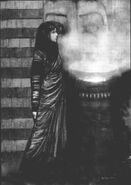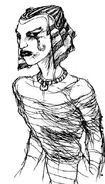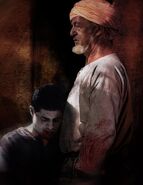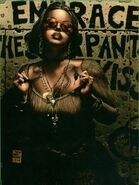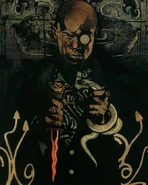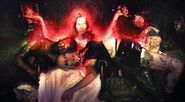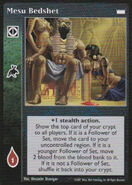The Ministry, also called the Ministry of Set, Followers of Set, or Setites, are a clan of vampires who believe their founder was the Egyptian god Set.
Overview[]
Orthodox Setite belief dictates that Set will one day return to rule or consume the world, and devout Setites prepare the way for his resurrection. To this end, the clan remains independent of the sects of other Kindred, and practice with great skill the arts of corruption, deceit and ancient sorcery. They refer to themselves as the Mesu Bedshet, the "Children of Rebellion".
History[]
Early History[]
In the First Nights, the Clan was fairly centered around its Antediluvian and, not surprisingly, Egypt. Many different tales are told about his divinity and how he was cursed by Ra in his struggle against his rival Osiris, whom he eventually managed to kill, and his abandonment by his disciples and fellow Antediluvians. In the manner of the Path of Typhon, all these accounts are taken for true, because limitation to just one version is just another sign of the influence of Ra and Osiris in this world.
It can be said that Set's get had a fairly great influence on Egypt as a whole during the days of pharaonic Egypt, although his efforts were always undermined by the Osirian League under the leadership of his eternal enemy Horus. Set himself guided his Clan from his great temple in Ombos and sometimes got involved personally with dethroning pharaohs who were too entrenched by Ma'at and the schemes of the Aeons. In this way, the Followers of Set established their hold on the lands of Egypt several times: First during the reign of the Hyksos (in an alliance with the Lasombra), then during the 19th dynasty under Ramesses and during the Hellenistic Age under Alexander the Great. During the reign of Rome, the Setites flourished in countless cults among the children of Seth and of Caine, promising ancient secrets and shaping the mindset of their cultists to resist the snares of Ma'at.
All these efforts were delivered a serious blow when Set himself disappeared in 33 CE (the alleged year of Christ's crucifixion, as some Setites note) or 33 BCE. After the departure of the founder, earthquakes shattered Egypt and many of the old temples sunk and became lost, often taking many of the slumbering methuselahs of the clan with them. However, Nakhthorheb and the remaining Hierophants took the reigns of the clan, ruling the progeny of Set in his absence.
Dark Ages[]
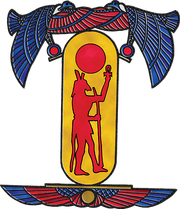
Setites were rare in Dark Medieval Europe, spending most of their time in Egypt. During this time, the first heresy appeared within the Clan, growing from Constantinople, where the rogue Hierophant Khay'tall had endorsed a philosophy of corruption for its own sake, rather than as a tool to break a person free from outside influences in the service of Set. While these "Decadents" or "Typhonists" were originally fairly confined to the Eastern Roman Empire, the fall of Constantinople in 1204 spread them across the whole known world, where they taught their debased philosophies and sometimes even practiced demonolatry. The Hierophants sought to bring the situation under control by banning these vampires from Egypt. In doing so, they made it impossible for them to learn their true history, leaving them to spread across Europe unhindered.

Script to represent Setites used by the Ashirra
Setites were known as Walid Set in the lands of Arabia and North Africa, and spent much of their time fighting to keep the influence of Europe out of their lands. Although they claimed to dominate Egypt, they actually only had a few holdings that could rightfully be called theirs; the rest belonged to the other bay't and the Garou of the Sahara. The clan they struggled against the most was the one with the greatest power over the Islamic regions and the Ashirra: the Banu Haqim. A temporary treaty was reached, but relations remained uneasy between the two for years afterward. The Clan had a deep enmity with the Ashirra, who viewed their idolatrous religion as blasphemy, while the Setites saw the faith that the Islamic vampires endorsed as a stifling of the natural order Set had sought to restore.[1]
The advent of learning during the Renaissance only increased the Setites' possibilities to subvert the European vampires, gaining advantage from the trade with goods from the Orient and the New World, as well as the new "leisure class" that arose in the cities, the customers for Set's teachings. The expansion of the Ottoman Empire also provided cover for them to travel into Europe and slave trade remained one of the most profitable businesses for the clan.
Victorian Age[]

The Setites reveled in the Victorian Age: As ancient knowledge was demanded more and more in Kindred society, the Setites' clientele rose more and more, as many Kindred discovered the usefulness of their bargains. The Setite presence in Camarilla cities during this time was increasingly high and some Princes allowed them even in their retinue. And with the strict puritan taboos of society, the increasing interest in occultism and the rising opium trade, corrupting mortals to the service of Set was easier than ever.
Despite the occupation of their ancestral homeland, the Setites were able to maintain a great deal of their influence in Egypt and some, like Izzat al-Khunzir, were actively opposing the foreign princes that occupied their ancient cities. Also, the clan expanded heavily into America in this time in order to corrupt and influence the young government of the States.
Modern Nights[]
In the Final Nights, many Setites saw the signs of Gehenna as portents that Set would soon arise, and indeed many Gehenna scenarios involve his return. They remained staunchly independent, but since they still had to acquire power and wealth to ease the return of their god, they ventured far from Egypt. Setites in this period frequently lived in Camarilla (or, less often, Sabbat) cities, seducing and corrupting other Kindred, staying outside sect politics except to serve their own ends. Few among the other clans trusted them, but they had many secrets and were often able to infiltrate a Prince's court by trading information or promising favors. Such deals generally worked out in the Setite's favor.
| “ | Different times in different places. The only ones who still use that name are in Africa, or of Egyptian descent. Now we’re… I guess we’re like the opening sequence of that TV show. You know, the one with the smiling Buddhas and floating pills, worship of sleek guns, sports cars, anything addictive... You can’t follow something inside of you. We are Set, now. We are his living church. His temple. All of our bodies belong to him. He can hear you now. | ” |
At some point following the start of Gehenna, the clan underwent a name change, now identifying themselves as the Ministry, save for those in Africa or of Egyptian descent, who still use the old name. In part it was a rebranding, an update for the times, but it was also a sign that the clan's understanding of its relationship to its founder had changed – rather than being Set's followers, they see Set as being within them, making them his living church.
With the start of the Beckoning, and the Sabbat's Gehenna Crusade, the Ministry found their home territories invaded. Deciding it was not a good time to be independent, they sought entrance to the Camarilla around the same time as the Banu Haqim, but were rejected. Many have turned to the Anarch Movement, and are now arming their twin weapons of temptation and subversion to bring spiritual liberation to all descendants of Caine.
In addition, some members of the Samedi bloodline have declined to join the Hecata in favor of joining the Ministry. In vampire domains, the Ministry comfortably serves two purposes. On one hand they are suppliers unafraid to dirty their hands with drugs, vessels, and anything else on the desperate side of the tracks. On the other, they are the spiritual core of many coteries. This dichotomy does not pass the Ministry by. They dance with the devil and preach spiritual purity. Though some licks consider them hypocrites for this mixed message, the Ministers claim the role of martyrs: They fraternize with sin so others need not. In this way, they retain plausible deniability. Most vampires accept this explanation, as the Ministers’ usefulness outweigh lingering most suspicions.
Organization[]
Setite organization is mostly local, with a single temple or network of cults representing a city's Serpent presence. Setites in the cities rarely scheme among each other, preferring to face outward threats in unity rather than the schismatic self-interest of the Sects. However, whispers persist among outsiders about a massive temple devoted to Set located somewhere in Africa, ruled by terrible methuselahs who claim to be the childer of Set himself.
The Hierophants or Eternals are the leaders of the Followers of Set in the absence of their founder. They are the oldest of their clan, who have known Set personally and acted as his stewards in the temples dedicated to the god.
Clan Variants[]
The Followers of Set are not as uniform as their name leads observers to believe. They found that the best way to preach their doctrine and philosophy in certain lands was to use parallels to each culture's indigenous myths and legends. In many of the religions around the world, Setites found Gods that bore a striking resemblance to the Lord of Storms, and proclaimed that these were in fact "masks" of Set himself. When contact was lost to the original Temple, several of these lines proclaimed themselves independent, and only in the Modern Nights have the lines, using mortal infrastructure, started communicating with their Egyptian forebears.
Like the castes of the Assamites, the Setites originally had a triumvirate system. The only surviving "caste" in the modern nights are the Priests, with the original Warrior caste having been supplanted and the Witches having gone extinct. All modern Setites are assumed to be members of the Priest caste unless otherwise specified.
Children of Damballah[]
- Main article: Children of Damballah
The Children of Damballah are a branch of Setites that dwells in sub-Saharan Africa, and are the African forefathers of the Serpents of the Light. The Children of Damballah revere Set as Damballah-Wedo, a Yoruban snake-god of the Earth and darkness. They keep their Founding Temple in the town of Oyo, once the capital of the Yoruba kingdom, but have since spread through most of West Africa. The main clan watches their African brethren with concern.
The Children have to present offerings to the spirits in a ritual that lasts at least ten minutes. If they fail to do this for any reason, the character suffers from the Haunted Flaw. Serpents of the Light descended from the Damballahns may suffer the same Flaw.
Daitya[]
The Daitya are a heretical variant, whose founder traveled from Egypt to India in pursuit of ancient mystical knowledge and hunting the Children of Osiris who were rumored to have fled into the Himalayas.[2] The bloodline was nearly exterminated during the reign of the Ashirra, who saw them not only as heathens, but as demon-worshippers. Only a grudging alliance with the Trimira during the Victorian Age saved their dwindling numbers from extinction.[2]
Certain broods and temples among the Daitya specialize in different skills, like a "yoga of illusion" that they call Raktamaya, which includes Chimerstry, Conjuration (Sadyojatavidya), Obfuscation, Transmutation (Rasayana), thaumaturgic rituals (tantras), hypnotism, and even prestidigitation.[3] The Daitya revere Shiva, and claim leadership of all vampires who worship Shiva. They adopted Shiva the Destroyer, Rudra the god of storms and hunters, and the serpent demon of drought – called Vritra – as the local analogs of Set.
Eventually the cult of Shiva completely absorbed the cult of Rudra, and Vritra simply dropped out of Setite practice. The Daitya see their caste duty as a strange inverse of mortal Brahminism. As demons, they must fight the gods and strive to overthrow the moral order of the world. As Brahmins, however, they must strive to keep their fellow vampires within their own particular caste duties as murderers, tricksters, desecrators of sacred rites and all the other abhorrent roles assigned to demons. Other vampires defy that claim. Nevertheless, their intrinsic rank as Brahmins grants all Daitya considerable authority among India's undead.[3]
Daitya perceive the current world as fundamentally flawed, so they seek to reboot it; the most fanatic among the Daitya claim that the means of doing so is to push the world over the brink into a nadir of purest evil, so that Shiva fully awakens to destroy the current world with his third eye, thereby setting the stage for the next cycle of existence.[3] They defy the elders in Egypt and demand treatment as a full-fledged and independent Clan. The Naktanchara lineage of the bloodline is rejected since they converted to Buddhism and began defying the caste system of Indian Kindred.[3]
Serpents of the Light[]
- Main article: Serpents of the Light
The Serpents of the Light are another heretical Setite variant – essentially "Setite antitribu" – who practice voodoun.
The Serpents of the Light began as a Caribbean branch of the West African Setites. According to their oral tradition, the first Setites came from Africa to the West Indies more than 300 years ago, in the heyday of the slave trade. The arrival of a vampire-priest smuggled across the Atlantic on a slave ship was an answer to the plea of their fellow tribesmen who were suffering and dying on the sugar plantations and mills. This great priest would led a furious slave revolt that was promptly crushed by Europeans.
The cult of the Serpents of the Light, however, was not crushed, nor the vampire priest who sleeps in the earth waiting for the moment when he will rise to lead all the faithful back to Africa. His lineage preserves the cult until this night. Their modern incarnation originated in the 1960s when a group of independent Setites in Haiti formed an alliance with the newly-arrived Sabbat, ignoring orders from senior Setites to have nothing to do with the sect.
The Serpents of the Light (or "Cobras" as they became informally known) are committed to combating the Antediluvians, and believe Set to be among their enemies; they are considered traitors by other Setites. Apart from their ideological and spiritual beliefs, however, there are no significant differences between Cobras and their parent clan: they learn the same Disciplines, and share the same weakness to light.
Tlacique[]
- Main article: Tlacique
The Tlacique reside in Latin America and are believed to be descended from the Followers of Set. Rather than Set, these Mesoamerican vampires venerate Tezcatlipoca, the god of the darkness and sorcery. This variant possesses Protean instead of the clan discipline of Serpentis, often taking the shape of a jaguar rather than a wolf. They also practice a unique type of shamanistic blood sorcery known as Nahuallotl.
In modern nights, the Tlacique are widely believed to be extinct by the few Kindred outside of the bloodline who even remember their existence. However, a handful of bitter survivors persist on the fringes of vampire society, scattered from the jungles and mountains of South America to barrios in the American Southwest. They Embrace exclusively from Native American groups, still resenting the European destruction of their homelands. Increasingly, they are forming an alliance with the Pisanob Necromancers.
Some of the younger Setites speculate and wonder if they have mistakenly adopted the Tlacique, confusing them with some obscure and dangerously ambitious Gangrel bloodline. Perhaps one composed of Embraced Balam Kinfolk.[4]
Walid Set[]
The Walid Set are the Arabian branch of the Setite clan. They are not a deviation in faith or blood from the original clan, as they still worship the vampire-god Set, and are frequently at odds with the Ashirra. Their greatest opponents in those lands, however, are the Assamite Viziers.
Warriors of Glycon[]
The Warriors of Glycon were a caste of the Setites during the Dark Ages that was later supplanted by the Warrior Setites.
The Crooks dedicated themselves to a philosophy of the exaltation of violence. Strength was all that mattered to them. In the triumvirate system of the old Clan, they saw themselves as the body, the priests as the mind, and the witches as the soul. Viewing themselves as the leaders of the Clan, they were blind before the intrigues of the priests that led to their demise.
The Warriors of Glycon had a weakness that made them obsessed with power, either through outright destruction or defeating enemies and putting them under the Blood Bond.
Warrior Setites[]
- Main article: Warrior Setites
The Warrior Setites are a specialized branch of the main Clan that came into existence after the end of the Warriors of Glycon. Claiming to play the original role of the clan as enforcers of Set, these Warrior Setites act as bodyguards and assassins for the main clan. They are proud and brutal soldiers for Set, and are perfectly willing to go into battle to back up their subtler brethren.
A mortal Embraced by a Viper becomes a "normal" member of the line (that is, learning Obfuscate as a Clan Discipline) unless trained as a warrior from childe-hood. The line is therefore an example of how training and ideology can change the basic makeup of a vampire's Clan.
Witches of Echidna[]
The Witches of Echidna were a caste of the Setites during the Dark Ages that were thought to have gone extinct around 1244. But some were able to survive in secrecy until the modern day, joining the Ministry and the Anarchs.
In contrast to the priests, the Gorgons dedicated themselves to a "mother of monsters" that they saw as the natural religion of their Clan. This figure was first revealed to mankind in northern Greece and named Echidna. Other primal serpent figures, like Ophion, Jörmungandr, Pytho, Hydra, and Draco, were seen as aspects of the mother. The witches divined the omens of their own downfall and of that of the Warriors.
The weakness of the Witches was that Echidna would manifest herself in her servants during Frenzy, resulting in an Appearance drop to zero during the Frenzy. In addition, each time a Witch used or consumed blood, Echidna "consumed" a point at the end of the scene. The only exception to this rule was the use of Setite Sorcery.
Culture[]
The mission of the Followers of Set can be stated in a single word: corruption. They seek to subvert and destroy whatever is good, noble, safe or beautiful within both Kindred and mortal society. They are plotters without peer, with an unequalled genius for misdirection and temptation. Their favorite weapons include drugs, sex, money, power, and vice in all its aspects.
But for most of the Followers of Set, this corruption is just a means to an end. They believe in a radical split between the divine, eternal soul and the corrupt, transitory world and body. The laws of their faith say that deep down, the soul knows it does not belong in a prison of matter. Anything that distracts the soul from this knowledge and ties it to the world must be a trap – and if the world is a prison, then the gods must be its jailers. To achieve liberation, a soul must shed all the false doctrines, cravings and habits that bind it and blind it. Such self-awareness cannot come from mere argument or faith. Only direct experience of the most extreme sort can break the hold of the gods over the soul and allow liberation. Through these experiences, the Setites believe they can achieve truly divine power over the world and liberate themselves from every physical and spiritual constraint, as they already have taken the first steps out of the prison when they received the Embrace.
It took the Setites some time to accept that they and other vampires are indeed a related, if not the same, species, and some Elders are still not wholly convinced. Vampires of other Clans were originally seen as pawns of other Egyptian gods, arranged against Set, or the work of evil spirits from the Underworld, who shared nothing with them but the fact that they too existed in both the material world and the afterlife. Befitting a Clan that holds truth as a tool of false gods, multiple explanations for their state were accepted. During the Dark Ages, common doctrine was that their akh, the "essence", has already descended to Duat, but that their bodies, through the waters of death (vitae), were still inhabited by their ba (personality) and ka (life essence).[5][6] Other systems, mainly used in Akhu, prescribed a detailed system centered around the nine-fold soul, with the khat as the body, the ba as one component of vitae, the ab as Humanity, the khaibit as the Beast, and the sekhem as another part of vitae, along with the other ka (the astral self), ren (the true name), khu (the aura) and sahu (the indestructible part of the soul, rumored by some Setites to later serve Set as a Sebau).[7]
As the oldest of the four independent clans, with a lineage directly traceable to a mighty Antediluvian (though there are those who dispute the clan's account of its own history), the Followers of Set are not without respect among the Kindred. At one point, after long and divisive debate, they were invited to join the Camarilla. This invitation was, by and large, ignored by the Setites (to the great relief of many in the Camarilla). Nonetheless, the Camarilla, and sometimes even the Sabbat, often seek out the Followers of Set in an effort to secure their aid in some complex intrigue or another. For this reason, the Setites are generally regarded as a necessary evil within Cainite society. In recent centuries, the Setites have achieved notable success in the Caribbean, where they are in direct control of many of the most feared and powerful Haitian secret societies and Jamaican posses. These organizations, in turn, control much of the international drug trade. The Setites are also rumored to have absolute control over at least one Near Eastern terrorist group.
The iconic serpent imagery used by the Clan is theorized by some scholars to be only prominent since the ascent of the Abrahamic religions, since Set is traditionally not associated with them. Older Setites are known to act irritated by the constant association with snakes, although several have wholeheartedly adopted the imagery for their own gain.[8]
Cults[]
The Followers of Set's emphasis on personal revelation generates dozens of little cults. Setite groups also emerge through interactions with the local culture. Put simply, Setites are not all a bunch of Egyptian migrants. Since their doctrine is flexible to begin with, Setites easily compromise with local cultures, adding still more diversity to the clan. A typical cult consists of a "Founding Temple" and several lesser temples scattered hither and yon. Egypt holds most of the really old and prestigious Founding Temples. A powerful cult's Hierophant, or senior priest, oversees the Founding Temple. The chief priests of important daughter temples are simply called High Priests. A priest who manages a small temple by herself bears no special title that the rest of the clan will honor.
Known cults are:
- Cult of Typhon Trismegistus
- Children of Damballah
- Cult of Taweret
- Cohort of Wepwawet
- Children of Judas
- Hall of Jörmungandr
- House of Eclipse
- Abd'al-Sobek
- Sisterhood of Sekhmet
- Church of the Black Magdalene
- The Fire Court
Embraces[]
Prospective childer for the Followers of Set often spend some time involved with a Setite cult, so they are indoctrinated in the mysteries of the Clan before becoming one of its Kindred. They may come from any cultural origin, though many are outsiders, loners, or otherwise marginalized by society, which is often what led them to the forbidden fruits offered by the cult of Set in the first place. Interestingly, Setites count their generation from Set, so their generation is often stated to be two steps lower than the standard counting method that derives vampires from Caine (a fourth generation methuselah would be noted as a member of the Second Generation within the Clan).[9]
Another facet is that some Followers of Set are not actually Embraced as Followers of Set. Rather, they are vampires from other Clans that have passed all their mysteries, accepted Set as their true god and have been formally inducted into the cult. While such vampires do not shed their original Clan or Clan Curse (a Ventrue converted to Set will still Embrace Ventrue childer and have a peculiar inclination towards his prey), they are taught Serpentis and Setite Sorcery, as well as their Paths of Enlightenment, freely. A convert from another Clan is not treated as a second-class citizen, but rather as a sibling of faith, which is a much more important distinction than blood. An outsider accepting the Dark God is a joyous event, even to the most conservative elder. There are even rumors of non-Kindred supernatural beings joining the cult.[10]
Weaknesses[]
Classic[]
Due to their inherent clan weakness, Followers of Set are extremely susceptible to sunlight (double damage) and have great difficulty acting while under bright light (spotlights, strobes, etc). On the other hand, Followers of Set are curiously immune to Basilisk's poison.[11]
Fifth Edition[]
Bane[]
In 5th Edition, the Bane of the Ministry is that their Blood abhors the light. When exposed to direct illumination – whether natural or artificial – members of the clan recoil. Ministers receive a penalty equal to their Bane Severity to all dice pools when subjected to bright light directed straight at them. Also, they add their Bane Severity to aggravated damage taken from sunlight.
Compulsion[]
Transgression: Set teaches that everyone's mind and spirit are bound by invisible chains of their own making. Their Blood chafes at these bindings and the Minister suffers a burning need to break them. The vampire receives a two-dice penalty to all dice pools not relating to enticing someone (including themselves) to break a Chronicle Tenet or personal Conviction, causing at least one Stain and ending this Compulsion.
Gallery[]
References[]
- ↑ VTDA: Veil of Night, p. 134-135


- ↑ 2.0 2.1 KOTE: Sunset Empires


- ↑ 3.0 3.1 3.2 3.3 VTM: Clanbook: Followers of Set Revised, p. 51


- ↑ VTM: Rites of the Blood, p. 81


- ↑ VTDA: Libellus Sanguinis 3: Wolves at the Door, p. 84

- ↑ DAV: Players Guide to Low Clans, p. 24


- ↑ VTM: Blood Sacrifice: The Thaumaturgy Companion, p. 18-19


- ↑ VTM: Beckett's Jyhad Diary, p. 461


- ↑ VTM: Clanbook: Followers of Set Revised, p. 59


- ↑ VTM: Lore of the Clans, p. 67


- ↑ VTDA: Book of Storyteller Secrets, p. 84

- VTM: The Players Guide, p. 121-125
| Vampire: The Masquerade Clans |
|---|
| Banu Haqim (Assamites) · Brujah · Gangrel · Hecata (Cappadocians, Giovanni) · Lasombra · Malkavian · Ministry (Followers of Set) · Nosferatu · Ravnos · Salubri · Toreador · Tremere · Tzimisce · Ventrue |



